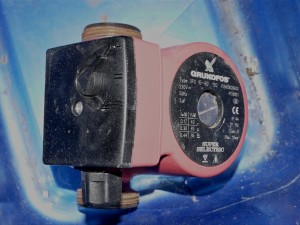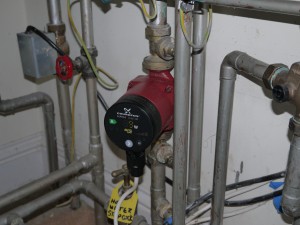All that studying over the last couple of years has made me a bit slow on the home hacking front, so when our central heating pump went a bit feral, I grabbed the opportunity unleash my inner geek, and build some intelligence into the central heating system,to drop its energy consumption.
The house already has thermostatic valves (TRVs) on all the radiators, which is great from an efficiency point of view, but the water pump wassn’t joining in the game. It just merrily pumps water around the system at the same pace, regardless of there being one radiator in action or 20. Sure, it is carefully calibrated to get the right flow rates, but as soon as one of the TRVs opens of closes, it is off. Merrily burning its way through 40 Watts (or 95 watts at full speed) of electricity for as long as the thermostat says the temperature is wrong in the hall. Naughty pump!
The little fellow in that picture has served us faithfully for over a decade, but last time I knocked the speed down (because it was being a bit noisy late at night), it said enough was enough and locked itself on full speed, and started to howl like a banshee. I’d read a bit about smart pumps before hand, and knew that Grundfos had drop in replacements for most of their models. The smart pumps essentially monitor the load on the system (through back pressure) and adjust their speed accordingly – Grundfos call is AUTOADAPT, and their Alpha2 model caught my eye – yes, I did read the product data sheet for a hot water pump :).
They also seem to control their onset and shut down speed, so you don’t get that nasty “thunk” noise so customary with central heating systems. Replacement doesn’t require any skills above the normal plumbing ones, it is literally a drop in replacement. The Alpha2 has a nifty little display on the front, which shows how much power the pump is consuming – there isn’t a monitoring output, but as it is LED based in a dark place, it would be fairly straight forward to set up an optical monitor for each digit to give an ‘off’ or > 10 watts reading. Yes, it uses less than 10 watts most of the time!
That’s the new unit in-situ. Most of the time it ticks over at about 9 watts, sometimes dropping down to 6, and very occasionally going up to 20 or so. It should cover it’s cost in power savings over the next couple of years, and the reduction in noise (particularly not being woken up by the heating coming on in the morning at silly-o-clock), is worth the price alone anyway. The house gets warm just as fast, if not faster, I get more sleep, a smaller electricity bill, and I can’t remember the last time I heard any noise coming from the central heating.
Very simple Home Hack – big win :)







